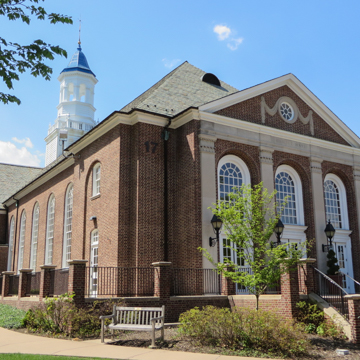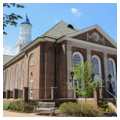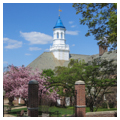Day and Klauder's handsome Georgian former chapel hints of the southern United States in its tower; it was placed to terminate a new quadrangle that was to be framed by academic buildings. In an unfortunate rehabilitation, it was stripped of its original windows and their brick surrounds by Ann Beha of Boston. Of the buildings intended by Day and Klauder to frame the new quadrangle, only the Fackenthal Laboratories (now the Harris Center for Business, Government, and Public Policy, 1928) was completed. To its rear is a handsome industrial power plant (Central Services Building) with a great smokestack also by Klauder that remains one of the most powerful buildings of the campus. Day and Klauder were fired in the 1930s when the board apparently discovered that their buildings were almost identical to similar buildings at Pennsylvania State University and the University of Delaware. They were supplanted by Philadelphia theater architect William H. Lee, who produced the third-rate Colonial Revival Keiper Humanities Building (1937) and redesigned the Shadek Library (1938 extended in a desultory manner by Bostonians Shepley, Bullfinch, Richardson and Abbott, who also designed the vacuous Weiss dormitory in 1990). Lee also designed the Appel Infirmary whose single story is inadequate to balance the Fackenthal Laboratories (now the Harris Center) and a cluster of 1950s and 1960s dormitories that have the appearance of public housing. His successor firm, Lee and Thaete, designed the modernistic 1960s Pfeiffer Science complex. Minoru Yamasaki designed the understated Steinman College Center in 1973–1976, shifting from the campus red brick. It is far from his best work of the period.
You are here
Hensel Hall
If SAH Archipedia has been useful to you, please consider supporting it.
SAH Archipedia tells the story of the United States through its buildings, landscapes, and cities. This freely available resource empowers the public with authoritative knowledge that deepens their understanding and appreciation of the built environment. But the Society of Architectural Historians, which created SAH Archipedia with University of Virginia Press, needs your support to maintain the high-caliber research, writing, photography, cartography, editing, design, and programming that make SAH Archipedia a trusted online resource available to all who value the history of place, heritage tourism, and learning.







